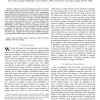Free Online Productivity Tools
i2Speak
i2Symbol
i2OCR
iTex2Img
iWeb2Print
iWeb2Shot
i2Type
iPdf2Split
iPdf2Merge
i2Bopomofo
i2Arabic
i2Style
i2Image
i2PDF
iLatex2Rtf
Sci2ools
INFOCOM
2007
IEEE
2007
IEEE
Transmit Power Distribution of Wireless Ad Hoc Networks with Topology Control
— Topology control and routing protocols are used by designers of wireless packet data networks to lower the node degree, simplify routing and lower the nodes’ energy consumption, while preserving strong connectivity. We assume a popular fading channel model and study the impact of several topology control schemes on the transmit power of nodes randomly distributed over a large area according to a Poisson point process, where each node controls the pattern of its one-hop neighbors by independently adjusting its transmit power. We provide the distribution of the transmit power of individual nodes under several different topology control algorithms, allowing designers to estimate the life time of battery energized devices, and the implications of choosing the nodes’ peak transmit power. We also allow easy comparisons between several different topology control algorithms with respect to the nodes’ power consumption.
| Added | 03 Jun 2010 |
| Updated | 03 Jun 2010 |
| Type | Conference |
| Year | 2007 |
| Where | INFOCOM |
| Authors | Dan Avidor, Sayandev Mukherjee, Furuzan Atay Onat |
Comments (0)

